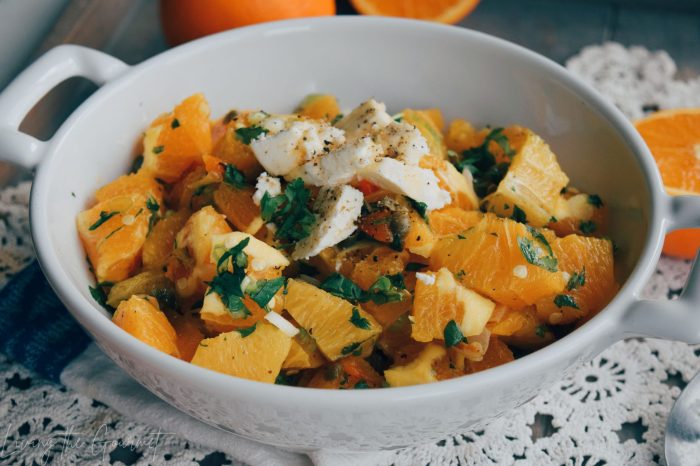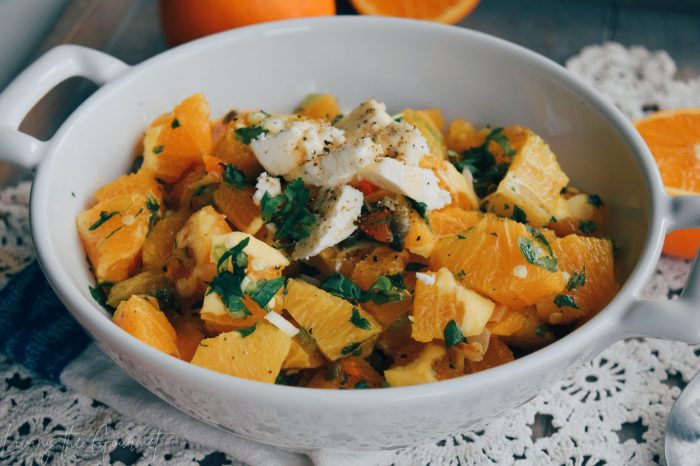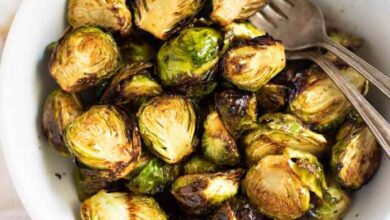
Turkish Orange Salad with Mediterranean Dressing: A Refreshing Delight
Turkish Orange Salad with Mediterranean Dressing is a vibrant and refreshing dish that perfectly captures the essence of Mediterranean cuisine. Imagine a symphony of flavors, with juicy orange segments dancing alongside crisp cucumbers, earthy olives, and aromatic herbs, all bathed in a tangy and aromatic dressing.
This salad is more than just a dish; it’s a culinary journey through the sun-drenched landscapes of Turkey, where fresh ingredients and bold flavors reign supreme.
The origins of this salad can be traced back to the ancient Ottoman Empire, where citrus fruits were a staple ingredient in both sweet and savory dishes. Over time, the salad evolved, incorporating elements of Greek and Middle Eastern cuisine, resulting in the delectable masterpiece we enjoy today.
Turkish Orange Salad with Mediterranean Dressing
This vibrant and refreshing salad, a true celebration of Mediterranean flavors, is a delightful culinary journey that transports you to the sun-drenched shores of Turkey. Its origins trace back to the rich culinary heritage of the region, where fresh ingredients and bold flavors are intertwined to create dishes that are both satisfying and invigorating.The Turkish Orange Salad with Mediterranean Dressing is a symphony of textures and tastes, showcasing the best of what the Mediterranean has to offer.
The star of the show is the juicy and tangy orange, its sweetness balanced by the peppery bite of fresh parsley and the earthy depth of red onion. The dressing, a vibrant blend of olive oil, lemon juice, and herbs, adds a layer of complexity and richness that elevates the salad to new heights.
Key Ingredients and Their Flavors
The key ingredients in this salad are carefully chosen for their unique flavors and textures, creating a harmonious balance that delights the palate.
- Oranges: The star of the show, oranges bring a burst of juicy sweetness and a tangy acidity that brightens the salad.
- Red Onion: Adds a subtle sharpness and a hint of sweetness, complementing the oranges beautifully.
- Parsley: Provides a fresh, herbaceous flavor and a vibrant green color that adds visual appeal.
- Olive Oil: The base of the dressing, olive oil lends a rich, fruity flavor and a smooth texture.
- Lemon Juice: Adds a bright, tangy note that balances the sweetness of the oranges and the richness of the olive oil.
- Salt and Pepper: Enhance the flavors of the other ingredients, bringing out their nuances.
Ingredients and Preparation: Turkish Orange Salad With Mediterranean Dressing

This vibrant salad is a perfect blend of sweet and tangy flavors, featuring juicy orange segments, crunchy vegetables, and a refreshing Mediterranean dressing. It’s a delightful and healthy choice for a light lunch or a side dish.
Ingredients
The ingredients list is simple and adaptable, allowing for variations based on personal preferences and available produce.
- Oranges:Use 2-3 large oranges, preferably seedless, for a generous amount of juicy segments.
- Vegetables:A combination of crisp vegetables enhances the salad’s texture and adds contrasting flavors. Choose from:
- Red Onion:Thinly sliced, about 1/4 cup, adds a sharp bite.
- Cucumber:Use about 1/2 cup, peeled and thinly sliced or diced, for refreshing coolness.
- Bell Peppers:Add about 1/2 cup of chopped bell peppers, either red, yellow, or green, for sweetness and color.
- Black Olives:Use about 1/4 cup of pitted black olives, sliced or halved, for a salty and briny touch.
- Fresh Herbs:Finely chopped fresh herbs like parsley, mint, or dill (about 1/4 cup total) add a burst of aroma and freshness.
- Mediterranean Dressing:
- Olive Oil:Use 3 tablespoons of good-quality extra virgin olive oil for a rich and flavorful base.
- Lemon Juice:Freshly squeezed juice from 1 lemon provides a tangy acidity.
- Honey:Add 1 tablespoon of honey for a touch of sweetness and to balance the acidity.
- Salt and Pepper:Season to taste with salt and freshly ground black pepper.
Preparation
The preparation process is straightforward, ensuring each ingredient is ready for the final assembly.
- Oranges:
- Cut the oranges in half.
- Carefully remove the segments by cutting along the membrane between each segment.
- Place the segments in a bowl.
- Vegetables:
- Thinly slice the red onion.
- Peel and thinly slice or dice the cucumber.
- Chop the bell peppers into small pieces.
- Slice or halve the black olives.
- Finely chop the fresh herbs.
- Combine all the prepared vegetables and herbs in a separate bowl.
- Mediterranean Dressing:
- In a small bowl, whisk together the olive oil, lemon juice, honey, salt, and pepper until well combined.
Assembling the Salad, Turkish orange salad with mediterranean dressing
The final step involves combining all the prepared ingredients for a delightful and refreshing salad.
- Combine the Oranges and Vegetables:Gently combine the orange segments with the prepared vegetables in a large bowl.
- Add the Dressing:Pour the Mediterranean dressing over the salad and toss gently to coat all the ingredients evenly.
- Serve Immediately:Serve the Turkish Orange Salad with Mediterranean Dressing immediately for the freshest flavors.
Mediterranean Dressing

The Mediterranean dressing is a vibrant and flavorful component of the Turkish Orange Salad, adding a tangy and herbaceous depth that complements the sweet and citrusy notes of the salad. It’s a simple dressing that can be made ahead of time and stored in the refrigerator for up to a week.
Mediterranean Dressing Ingredients and Preparation
The Mediterranean dressing is typically made with a base of olive oil, lemon juice, and red wine vinegar. Herbs such as oregano, thyme, and parsley are added for their aromatic qualities, while a pinch of salt and pepper enhances the overall flavor.To prepare the dressing, whisk together the olive oil, lemon juice, red wine vinegar, herbs, salt, and pepper in a small bowl.
Taste and adjust the seasoning as needed. You can also add a touch of honey or maple syrup for a slightly sweeter dressing.
Flavor Profile and Complementarity
The Mediterranean dressing has a balanced flavor profile, combining the tanginess of lemon juice and red wine vinegar, the richness of olive oil, and the herbaceous aroma of the herbs. This combination creates a dressing that is both refreshing and flavorful, perfectly complementing the sweet and citrusy notes of the Turkish Orange Salad.
Alternative Dressing Options
While the traditional Mediterranean dressing is delicious, there are several alternative options that can be used to add variety to the Turkish Orange Salad.
Alternative Dressing Options
- Citrus Vinaigrette:This dressing is made with a base of orange juice, lemon juice, and olive oil. It’s a bright and refreshing option that complements the citrus notes of the salad.
- Honey-Mustard Dressing:This dressing is made with a base of honey, Dijon mustard, and olive oil. It’s a sweet and tangy option that adds a creamy texture to the salad.
- Tahini Dressing:This dressing is made with a base of tahini, lemon juice, and water. It’s a nutty and creamy option that adds a unique flavor to the salad.
Serving Suggestions
This Turkish Orange Salad with Mediterranean Dressing is a versatile dish that can be enjoyed in many different ways. Whether you’re looking for a light and refreshing lunch, a flavorful side dish for dinner, or a vibrant addition to a party spread, this salad has you covered.
The tangy sweetness of the Turkish orange salad with its Mediterranean dressing is a perfect contrast to the savory flavors of a good asian beef and vegetable stir fry. The bright citrus notes of the salad cut through the richness of the stir fry, creating a harmonious blend of textures and tastes.
I love serving this salad alongside the stir fry for a balanced and satisfying meal.
Serving Suggestions
The salad can be served in various ways to suit your preferences and the occasion. Here are some ideas:
- Individual portions:Serve the salad in individual bowls for a casual and elegant presentation.
- Shared platter:Arrange the salad on a large platter for a communal dining experience. You can add additional toppings like toasted pine nuts or crumbled feta cheese for visual appeal and extra flavor.
- Salad bar:Set up a salad bar with various ingredients and dressings, allowing guests to customize their own bowls. This is a great option for parties and gatherings.
Complementary Dishes and Beverages
The salad’s bright and citrusy flavors pair well with a variety of dishes and beverages. Here are some suggestions:
- Grilled chicken or fish:The salad’s refreshing acidity complements the richness of grilled meats and seafood.
- Roasted vegetables:The salad adds a burst of freshness to hearty roasted vegetables like sweet potatoes or asparagus.
- Hummus and pita bread:This classic Mediterranean combination provides a satisfying and flavorful accompaniment.
- White wine or rosé:The salad’s citrus notes pair well with dry white wines or crisp rosés.
Incorporating the Salad into a Larger Meal or Event
This salad can be a key component of various meals and events:
- Lunch or dinner:Serve the salad as a main course with grilled chicken or fish or as a side dish with roasted vegetables.
- Potluck or picnic:The salad is easy to transport and can be served at room temperature, making it ideal for potlucks and picnics.
- Buffet:Include the salad as part of a buffet spread, offering a healthy and flavorful option for guests.
Variations and Adaptations

This Turkish Orange Salad with Mediterranean Dressing is a versatile dish that can be adapted to your preferences and dietary needs. Experiment with different ingredients, adjust the dressing, and create your own unique version of this refreshing salad.
The bright, citrusy flavors of Turkish orange salad with Mediterranean dressing are a perfect complement to a hearty meal. For dessert, I love to balance the tanginess with a sweet and comforting treat like this rhubarb upside down cake i.
The combination of the tart rhubarb and the buttery cake is a classic for a reason. Back to the salad, I like to use a mix of fresh herbs and crunchy vegetables, making it a delightful and refreshing addition to any table.
Ingredient Substitutions and Additions
Adding different ingredients can enhance the flavor and texture of the salad.
- Citrus Fruits:Substitute oranges with grapefruit, mandarins, or blood oranges for a different flavor profile.
- Other Fruits:Incorporate seasonal fruits like strawberries, raspberries, or blueberries for a sweet and tangy twist.
- Vegetables:Add chopped cucumber, bell peppers, red onion, or celery for added crunch and freshness.
- Nuts and Seeds:Sprinkle toasted almonds, walnuts, pumpkin seeds, or sunflower seeds for a nutty crunch and healthy fats.
- Herbs:Experiment with fresh herbs like mint, parsley, cilantro, or dill for aromatic flavors.
- Cheese:Crumble feta cheese or goat cheese for a salty and tangy element.
Dietary Adaptations
This salad can be adapted for various dietary restrictions and preferences.
- Vegan:Omit the feta cheese and use a vegan alternative. Ensure the dressing is vegan by using a vegan honey substitute.
- Gluten-Free:Use gluten-free bread for croutons, if desired.
- Low-Carb:Reduce the amount of bread or omit it entirely.
- Dairy-Free:Substitute feta cheese with a dairy-free alternative or omit it entirely.
Creative Variations
Try these creative variations to enhance the flavor and texture of the salad.
Turkish orange salad with its Mediterranean dressing is a delightful burst of fresh flavors, but sometimes you crave something a bit more savory and nutty. That’s when I turn to chef John’s almond arugula pesto , a rich and vibrant sauce that complements the salad perfectly.
The pesto’s earthy notes and crunchy almonds add a wonderful depth to the citrusy brightness of the orange salad, making for a truly satisfying and balanced meal.
- Grilled Orange Salad:Grill the orange slices for a smoky flavor. Serve with a balsamic vinaigrette.
- Orange and Avocado Salad:Add diced avocado for a creamy and healthy twist. Drizzle with a lime vinaigrette.
- Orange and Shrimp Salad:Toss cooked shrimp with the salad for a protein-rich meal. Serve with a lemon vinaigrette.
- Orange and Quinoa Salad:Add cooked quinoa for a hearty and satisfying salad. Use a citrus vinaigrette.
Nutritional Information
This vibrant Turkish Orange Salad with Mediterranean Dressing is not just a feast for the eyes but also a nutritional powerhouse. Let’s delve into the health benefits of this refreshing salad.
Nutritional Breakdown
The salad is a good source of essential vitamins, minerals, and antioxidants. The key ingredients contribute significantly to the overall nutritional profile.
- Oranges: Oranges are a rich source of Vitamin C, an essential antioxidant that supports immune function and collagen production. They also provide folate, potassium, and fiber, contributing to heart health and digestion.
- Cucumber: Cucumbers are low in calories and high in water content, making them a refreshing and hydrating addition to the salad. They also contain vitamins K and C, as well as minerals like potassium and magnesium.
- Red Onion: Red onions are a good source of quercetin, a powerful antioxidant linked to various health benefits, including anti-inflammatory and anti-cancer properties. They also provide fiber and vitamin C.
- Fresh Herbs: The use of fresh herbs like parsley and mint adds flavor and a boost of nutrients. Parsley is rich in vitamin K, vitamin C, and folate, while mint is known for its digestive benefits and potential anti-inflammatory properties.
- Mediterranean Dressing: The Mediterranean dressing, made with olive oil, lemon juice, and herbs, is a healthy and flavorful option. Olive oil is a rich source of monounsaturated fats, known to improve heart health. Lemon juice provides vitamin C and antioxidants, while the herbs add flavor and nutritional value.
Dietary Considerations
While this salad is generally healthy and well-balanced, some dietary considerations are important:
- Allergies: Individuals with allergies to citrus fruits, onions, or herbs should avoid this salad. Always check ingredient lists and consult with a healthcare professional if you have any food allergies or sensitivities.
- Sodium Content: The Mediterranean dressing may contain a moderate amount of sodium. Individuals with high blood pressure or other health concerns should monitor their sodium intake.
- Fiber Content: The salad contains fiber from oranges, cucumbers, and red onions. While fiber is beneficial for digestion, consuming too much fiber too quickly can cause gastrointestinal discomfort. Start with smaller portions and gradually increase the amount as needed.
Visual Presentation
The visual appeal of a dish is just as important as its taste. Turkish Orange Salad with Mediterranean Dressing is a feast for the eyes, with its vibrant colors and fresh ingredients. A well-presented salad will entice your guests and make the dish even more enjoyable.
Image Showcase
The visual appeal of the Turkish Orange Salad with Mediterranean Dressing is enhanced by the combination of fresh, vibrant ingredients.
| Image | Description |
|---|---|
| [Image of a bowl of Turkish Orange Salad with Mediterranean Dressing] | A beautiful bowl of salad showcasing the vibrant orange segments, crisp greens, and the creamy Mediterranean dressing. The salad is arranged artfully, highlighting the different textures and colors. |
| [Image of sliced oranges] | Juicy orange segments, glistening with their natural oils, add a burst of color and sweetness to the salad. |
| [Image of fresh herbs] | Aromatic herbs like parsley, mint, and dill, add a fresh and fragrant element to the salad, creating a visually appealing contrast. |
| [Image of the Mediterranean Dressing] | The creamy Mediterranean dressing, with its subtle hints of lemon and garlic, adds a luxurious touch to the salad. |
Additional images could showcase the preparation process, such as:
- Chopping the fresh vegetables
- Combining the ingredients in a bowl
- Drizzling the Mediterranean dressing over the salad
- Serving the salad on a platter or in individual bowls
These images would further enhance the visual appeal of the recipe and provide a more comprehensive understanding of the dish’s presentation.






